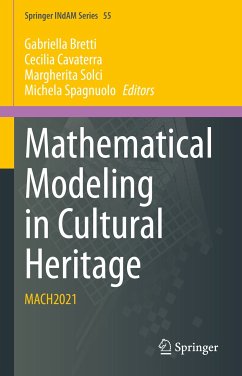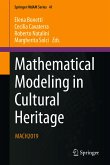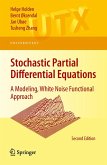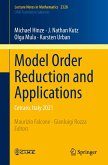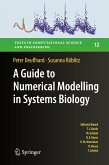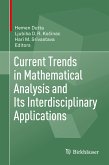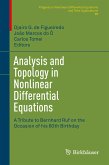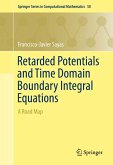Mathematical Modeling in Cultural Heritage (eBook, PDF)
MACH2021
Redaktion: Bretti, Gabriella; Spagnuolo, Michela; Solci, Margherita; Cavaterra, Cecilia


Alle Infos zum eBook verschenken

Mathematical Modeling in Cultural Heritage (eBook, PDF)
MACH2021
Redaktion: Bretti, Gabriella; Spagnuolo, Michela; Solci, Margherita; Cavaterra, Cecilia
- Format: PDF
- Merkliste
- Auf die Merkliste
- Bewerten Bewerten
- Teilen
- Produkt teilen
- Produkterinnerung
- Produkterinnerung

Hier können Sie sich einloggen

Bitte loggen Sie sich zunächst in Ihr Kundenkonto ein oder registrieren Sie sich bei bücher.de, um das eBook-Abo tolino select nutzen zu können.
This book collects contributions presented at the INdAM Workshop "Mathematical modeling and Analysis of degradation and restoration in Cultural Heritage-MACH2021", held in Rome, Italy in September 2021. The book is focused on mathematical modeling and simulation techniques with the aim of improving the current strategies of conservation and restoration in cultural heritage, sharing different experiences and approaches. The main topics are corrosion and sulphation of materials, damage and fractures, stress in thermomechanical systems, contact and adhesion problems, and phase transitions.
- Geräte: PC
- ohne Kopierschutz
- eBook Hilfe
- Größe: 10.85MB
![Mathematical Modeling in Cultural Heritage (eBook, PDF) Mathematical Modeling in Cultural Heritage (eBook, PDF)]() Mathematical Modeling in Cultural Heritage (eBook, PDF)73,95 €
Mathematical Modeling in Cultural Heritage (eBook, PDF)73,95 €![Stochastic Partial Differential Equations (eBook, PDF) Stochastic Partial Differential Equations (eBook, PDF)]() Helge HoldenStochastic Partial Differential Equations (eBook, PDF)61,95 €
Helge HoldenStochastic Partial Differential Equations (eBook, PDF)61,95 €![Model Order Reduction and Applications (eBook, PDF) Model Order Reduction and Applications (eBook, PDF)]() Michael HinzeModel Order Reduction and Applications (eBook, PDF)48,95 €
Michael HinzeModel Order Reduction and Applications (eBook, PDF)48,95 €![A Guide to Numerical Modelling in Systems Biology (eBook, PDF) A Guide to Numerical Modelling in Systems Biology (eBook, PDF)]() Peter DeuflhardA Guide to Numerical Modelling in Systems Biology (eBook, PDF)40,95 €
Peter DeuflhardA Guide to Numerical Modelling in Systems Biology (eBook, PDF)40,95 €![Current Trends in Mathematical Analysis and Its Interdisciplinary Applications (eBook, PDF) Current Trends in Mathematical Analysis and Its Interdisciplinary Applications (eBook, PDF)]() Current Trends in Mathematical Analysis and Its Interdisciplinary Applications (eBook, PDF)89,95 €
Current Trends in Mathematical Analysis and Its Interdisciplinary Applications (eBook, PDF)89,95 €- -31%11
![Analysis and Topology in Nonlinear Differential Equations (eBook, PDF) Analysis and Topology in Nonlinear Differential Equations (eBook, PDF)]() Analysis and Topology in Nonlinear Differential Equations (eBook, PDF)73,95 €
Analysis and Topology in Nonlinear Differential Equations (eBook, PDF)73,95 € ![Retarded Potentials and Time Domain Boundary Integral Equations (eBook, PDF) Retarded Potentials and Time Domain Boundary Integral Equations (eBook, PDF)]() Francisco-Javier SayasRetarded Potentials and Time Domain Boundary Integral Equations (eBook, PDF)73,95 €
Francisco-Javier SayasRetarded Potentials and Time Domain Boundary Integral Equations (eBook, PDF)73,95 €-
-
-
Dieser Download kann aus rechtlichen Gründen nur mit Rechnungsadresse in A, B, BG, CY, CZ, D, DK, EW, E, FIN, F, GR, HR, H, IRL, I, LT, L, LR, M, NL, PL, P, R, S, SLO, SK ausgeliefert werden.
- Produktdetails
- Verlag: Springer Nature Singapore
- Seitenzahl: 224
- Erscheinungstermin: 7. August 2023
- Englisch
- ISBN-13: 9789819936793
- Artikelnr.: 68548727
- Verlag: Springer Nature Singapore
- Seitenzahl: 224
- Erscheinungstermin: 7. August 2023
- Englisch
- ISBN-13: 9789819936793
- Artikelnr.: 68548727
- Herstellerkennzeichnung Die Herstellerinformationen sind derzeit nicht verfügbar.
